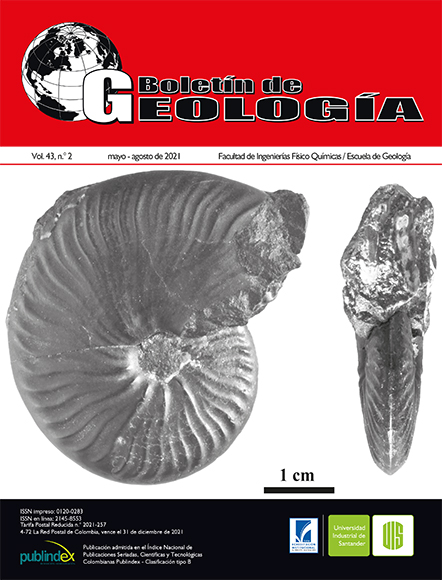Mapping of indirect indices of hydrocarbon manifestations in the Gulf of Guacanayabo, Cuba
Published 2021-05-31
Keywords
- Bathymetry,
- Pockmarks,
- Hydrocarbons,
- Seismic,
- Mud volcanoes
How to Cite
Altmetrics
Abstract
The need to have gas and oil reserves is imperative in the contemporary world and in the case of Cuba the situation is accentuated due to external factors. For this reason, numerous investigations are carried out in the national territory to locate favorable structures where accumulations of hydrocarbons can be found. The objective of this research has been to study the marine sediments of the Gulf of Guacanayabo (Eastern Cuba), the indications of hydrocarbons in the seabed and the establishment of the areas of greatest interest. For this study, the combined use of bathymetry and high-resolution reflection seismic was used to map anomalous structures classified as possible pockmarks and mud volcanoes, morphologies generated by natural hydrocarbon emissions in the seabed. Likewise, the relationship between gaseous emanations and the presence of gas in the sediments of the seabed and the deep and shallow structures in the region has been established. Finally, the areas with the greatest potential have been established from the integration of all the available results. This study allows to ensure the potentialities of the Gulf of Guacanayabo for subsequent studies in relation to the presence of hydrocarbons in the subsoil.
Downloads
References
Álvarez-Ortiz, M.; Perdomo-Castillo, J.L.; Pro-Betancourt, J.L.; Hernández-Valdés, O.; Veliz-Basabe, J.M.; Miró-Pagés, G. (2007). Consideraciones de la reinterpretación de datos geofísicos en la Bahía de Cárdenas, referentes a la exploración petrolera. Provincia de Matanzas. II Convención Cubana de Ciencias de la Tierra. III Congreso de Geofísica. La Habana, Cuba.
Álvarez-Ortiz, M.; Morales-Carrillo, I.; Perdomo-Castillo, J.L. (2017). Detección con sísmica de alta resolución de evidencias de manifestaciones de hidrocarburos al sur del Golfo de Guacanayabo. VII Convención Cubana de Ciencias de la Tierra. IX Congreso de Geofísica. La Habana, Cuba.
Audsley, A.; Bradwell, T.; Howe, J.A.; Baxter, J.M. (2019). Distribution and classification of pockmarks on the seabed around western Scotland. Journal of Maps, 15(2), 807-817. https://doi.org/10.1080/17445647.2019.1676320
Betzler, C.; Lindhorst, S.; Hübscher, C.; Lüdmann, T.; Fürstenau, J.; Reijmer, J. (2011). Giant pockmarks in a carbonate platform (Maldives, Indian Ocean). Marine Geology, 289(1-4), 1-16. https://doi.org/10.1016/j.margeo.2011.09.004
Ceramicola, S.; Dupré, S.; Somoza, L.; Woodside, J. (2018). Cold seep systems. In: A. Micallef, S. Krastel, A. Savini (eds.). Submarine geomorphology (pp. 367-387). Springer. https://doi.org/10.1007/978-3-319-57852-1_19
Ercilla, G.; Baraza, J. (1996). Evidencias de gas en sedimentos del talud del Golfo de Cádiz. Geogaceta, 20(1), 180-182.
García-Gil, S.; García-García, A.; Vilas, F. (1999). Identificación sísmico-acústico de las diferentes formas de aparición de gas en La Ría de Vigo (NO de España). Revista Sociedad Geológica de España, 12(2), 301-307.
García-Gil, S.; García-García, A.; Durán, R.; Vilas, F. (2000). Estratigrafía sísmica de alta resolución en las Rías Baixas: Pontevedra y Vigo (NO España). Journal of Iberian Geology, 26, 217-231.
Gay, A.; Lopez, M.; Cochonat, P.; Séranne, M.; Levaché, D.; Sermondadaz, G. (2006). Isolated seafloor pockmarks linked to BSRs, fluid chimneys, polygonal faults and stacked Oligocene–Miocene turbiditic palaeochannels in the Lower Congo Basin. Marine Geology, 226(1-2), 25-40. https://doi.org/10.1016/j.margeo.2005.09.018
Hovland, M.; Gardner, J.V.; Judd, A.G. (2002). The significance of pockmarks to understanding fluid flow processes and geohazards. Geofluids, 2(2), 127-136. https://doi.org/10.1046/j.1468-8123.2002.00028.x
Iturralde-Vinent, M.A.; García-Casco, A. (2011). Compendio de Geología de Cuba y del Caribe. Segunda Edición, CITMATEL.
King, L.H.; MacLean, B. (1970). Pockmarks on the Scotian Shelf. GSA Bulletin, 81(10), 3141-3148. https://doi.org/10.1130/0016-7606(1970)81[3141:POTSS]2.0.CO;2
Krämer, K.; Holler, P.; Herbst, G.; Bratek, A.; Ahmerkamp, S.; Neumann, A.; Bartholomä, A.; van Beusekom, J.E.; Holtappels, M.; Winter, C. (2017). Abrupt emergence of a large pockmark field in the German Bight, southeastern North Sea. Scientific Reports, 7. https://doi.org/10.1038/s41598-017-05536-1
León, R.; Somoza, L.; Medialdea, T.; Hernández-Molina, F.J.; Vázquez, J.T.; Díaz-del-Río, V.; González, F.J. (2010). Pockmarks, collapses and blind valleys in the Gulf of Cádiz. Geo-Marine Letters, 30(3-4), 231-247. https://doi.org/10.1007/s00367-009-0169-z
Leyva-Ramos, E. (2017). Cartografía de estructuras geológicas que evidencien índices de manifestaciones de hidrocarburos en el Golfo de Guacanayabo. Tesis, Universidad Tecnológica de La Habana “José Antonio Echeverría”, La Habana, Cuba.
Morales-Carrillo, I.; Álvarez-Castro, J.; González-Caraballo, R.; Miró-Pagés, G. (2014). Alternativas para la exploración petrolera en los mares al sur de Cuba. Revista Cubana de Ingeniería, 5(1), 19-25.
Morales-Carrillo, I. (2019). Anomalías sísmicas de interés para la exploración de hidrocarburos en el Golfo de Guacanayabo. VIII Convención de Ciencias de la Tierra. VII Congreso de Petróleo y Gas. La Habana, Cuba.
Quintero-Ramírez, J.D. (2012). Interpretación sísmica de volcanes de lodo en la zona occidental del abanico del delta del río Magdalena, Caribe colombiano. Tesis, Universidad EAFIT, Medellin, Colombia.
Rejas-Alejos, M. (2009). Génesis de carbonatos autigénicos asociados a volcanes de fango del Golfo de Cádiz (SW España): influencia de procesos bioquímicos y desestabilización de hidratos de gas. Tesis Doctoral, Universidad de Barcelona, España.
Somoza, L.; Gardner, J.M.; Díaz‐del‐Río, V.; Vázquez, J.T.; Pinheiro, L.M.; Hernández‐Molina, F.J.; TASYO/ANASTASYA shipboard scientific parties. (2002). Numerous methane gas‐related sea floor structures identified in Gulf of Cadiz. Eos, Transactions American Geophysical Union, 83(47), 541-549. https://doi.org/10.1029/2002EO000371
Somoza, L.; Díaz-del-Río, V.; León, R.; Ivanov, M.; Fernández-Puga, M.C.; Gardner, J.M.; Hernández-Molina, F.L.; Pinheiro, L.M.; Rodero, J.; Lobato, A.; Maestro, A.; Vázquez, J.T.; Medialdea, T.; Fernández-Salas, L.M. (2003). Seabed morphology and hydrocarbon seepage in the Gulf of Cádiz mud volcano area: Acoustic imagery, multibeam and ultra-high resolution seismic data. Marine Geology, 195(1-4), 153-176. https://doi.org/10.1016/S0025-3227(02)00686-2
Somoza, L.; Medialdea, T.; León, R.; Ercilla, G.; Vázquez, J.T.; Farran, M.; Hernández-Molina, J.; González, J.; Juan, C.; Fernández-Puga, M.C. (2012). Structure of mud volcano systems and pockmarks in the region of the Ceuta Contourite Depositional System (Western Alborán Sea). Marine Geology, 332-334, 4-26. https://doi.org/10.1016/j.margeo.2012.06.002
Spina, R. (2017). The pockmark stars: radial structures in the seabed surrounding the Hawaii Islands. Journal of Environmental Geology, 1(1), 33-50.
Spina, R. (2018). Pockmarks as indicators to decipher some natural phenomena in the field of geology and beyond: state of knowledge and its implications. Journal of Environmental Geology, 2(S1), 1-2.

